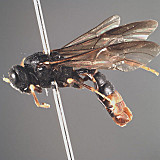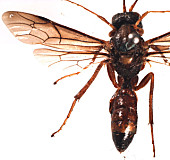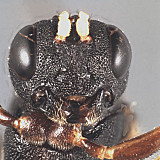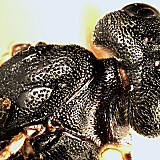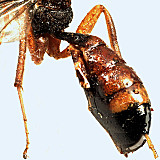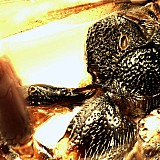Type species: Dictyopheltes robustus Gauld, 1984, by original designation.
Dictyopheltes
stated that Dictyopheltes lacked a glymma. A glymma-like depression is present in nearly all individuals that we examined (Zhaurova and Wharton 2009), but is much different in appearence than the glymma of Westwoodia, Gauldia and Hypopheltes. It is narrow, shallow to distinctly impressed and almost slit-like in at least one specimen. Three specimens were examined, representing three species. These included two undescribed species noted by Gauld (1984): his “sp. 2” from Clunes and an undescribed species from Bin Bin Range that lacks a fore wing areolet.
Queensland: Bin Bin Range via Didcot and Swan River (both BMNH); Victoria: Clunes, bred 7.iv.1958, Eucalyptus leucoxylon ex Perga leaski Benson (BMNH).
There are no specimens currently determined for this OTU, or those specimens determined for this OTU are not yet mappable.
This work would not have been possible without the groundwork provided by Ian Gauld’s study of the Australian fauna, and we are particularly grateful for his assistance in many aspects of this study. We also thank the following curators and researchers for extended loans of the material used for the revision of Scolobatini and Westwoodiini: David Wahl (AEIC), John LaSalle (ANIC), Ian Gauld and Gavin Broad (BMNH), Andy Bennett (CNC), Gabriel Melo (DZUP), Anders Albrecht and Pekka Malinen (FMNH), Ronald Zúñiga (INBio), Ken Walker (MVMA), Hege Vårdal (NHRS), Chris Burwell (QM), and Dave Furth (USNM). Matt Yoder provided considerable assistance along the way, particularly with databasing. Images used here were obtained through the combined efforts of Kira Zhaurova, Heather Cummins, and Patricia Mullins. Our use of PURLs (http://purl.oclc.org) follows the example of their use in publications by Norm Johnson. This content is based upon work conducted at Texas A&M University and supported by the National Science Foundation’s PEET program under Grant No. DEB 0328922 and associated REU supplement nos DEB 0723663 and DEB 0616851. Page last updated April, 2011.
This material is based upon work supported by the National Science Foundation under Grant Number DEB 0328922 with REU supplements DEB 0723663 and DEB 0616851.
Any opinions, findings, and conclusions or recommendations expressed in this material are those of the author(s) and do not necessarily reflect the views of the National Science Foundation.

